Creating a successful app monetizationThe process of generating revenue from an app or service. approach in today’s highly competitive market requires more than just a great product; it necessitates a well-thought-out strategy focused on App Store Optimization (ASO).
The most advantageous ASO revenue models make all the difference.
In this article, we’ll look into the most crucial ASO revenue models, providing you the capacity to ensure you’re getting the most out of your app’s earning potential.
We’ll equip users with the abilities required to make informed judgments about how to make the most using your app store presence, whether they’re beginning from the start or maximizing their present app.
No one method of monetizing your app is best.
There are many ASO revenue models to consider, and the one that’s ideal for you most likely depends on your perfect user, functionality, and business plan.
- Subscription-Based Models: Maximizing Recurring Income
- In-App Purchases: Enhancing User Experience and Profits
- Freemium Models: Creating the Perfect Balance Between Free and Paid ASO Revenue Models
- Ad-Based Models: Monetizing Through In-App Ads
- In-App Purchase Types: To Optimize User Experience & Revenue
- Hybrid Revenue Models: Strategy Collision For The Win
- App Store Revenue Optimization ASO Models — A Conclusion
- App Store Revenue Optimization FAQ
Subscription-Based Models: Maximizing Recurring Income
One of the most accessible choices is a subscription-based monetization approach in the business.
Their overall acceptance grows because it’s how many services and products are sold since they’re often regularly serviced or defined.
A free trial period gives users the chance to experience your app’s value at no risk before committing to a subscription.
If users are happy with your app, they’re more likely to pay for your product.
While subscription models are ideal for generating recurring revenue, they place a financial burden on you to continually provide value to customers whose subscriptions are still valid.
However, it’s not something to worry about.
Engage with them, and they’ll stay subscribed.
Subscription models require continuous engagement to retain recurring revenue, emphasizing the need for consistent value delivery.
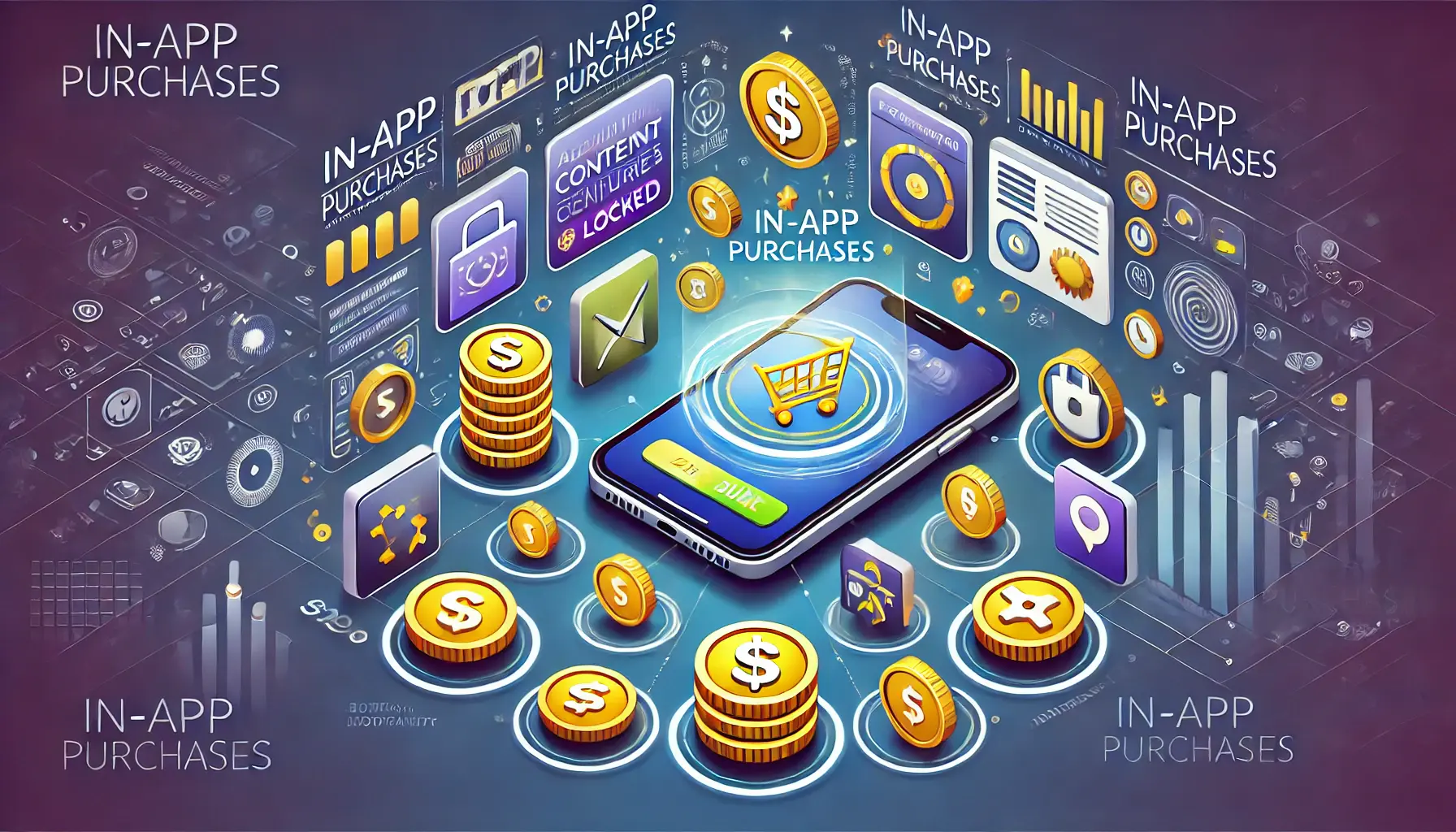
Visual representation of in-app purchases, highlighting how they enhance user experience and drive app profitability.
In-App Purchases: Enhancing User Experience and Profits
In-app purchases enhance user experience and can add extra money to your bottom line.
Users can buy extra content or features in your app through in-app purchases.
This ASO revenue model is best used in games and other apps in which users acquire in-app products to bolster their experience.
It is essential to ensure items obtained through in-app purchases add real value to users without forcing them to spend money.
- Clearly differentiate free vs. paid features: Free users should always know how much more they can get by upgrading to a premium plan.
- Optimize the onboarding experience: As free users start to explore your app, lead them through all the free features but also showcase the benefits of the paid ones.
- Use limited-time offers: This is one of the best ways to urge free users to turn into paying ones. You can motivate them by showcasing discounted banner ads or new features.
Overall, with the right amount of free value and the right price for premium features, your app will bring you a stable stream of income through effective ASO strategies.
In-app purchases are a powerful tool for enhancing both user experience and profitability, especially when balanced with free offerings.

Illustration of the freemium model, highlighting the balance between free and paid features in mobile apps.
Freemium Models: Creating the Perfect Balance Between Free and Paid ASO Revenue Models
The freemiumA pricing strategy that offers a basic version for free while charging for premium features. model is a widely used ASO revenue model that allows users to access the app for free but charges them for premium features.
If implemented properly, it can help you quickly build up a user base while still making money from those willing to pay for special abilities.

Visual representation of the clear distinction between free and paid features in a mobile app.
Clearly Define the Difference Between Free and Paid Features
Making a clear distinction between what is available for free and what can only be accessed upon upgrading is essential to maximize the freemium ASO revenue model’s potential.
- Highlight Premium Bonuses: The premium version should provide features and rewards worth paying for. For example, only the premium version may have extra content, full app functionality, or no ads.
- Clear Messages: Whether with banners, pop-ups, or notifications, ensure your users are well-informed of the free services’ restrictions. Use your app’s marketing messages and in-app notifications to clearly show users why they should consider a premium plan.
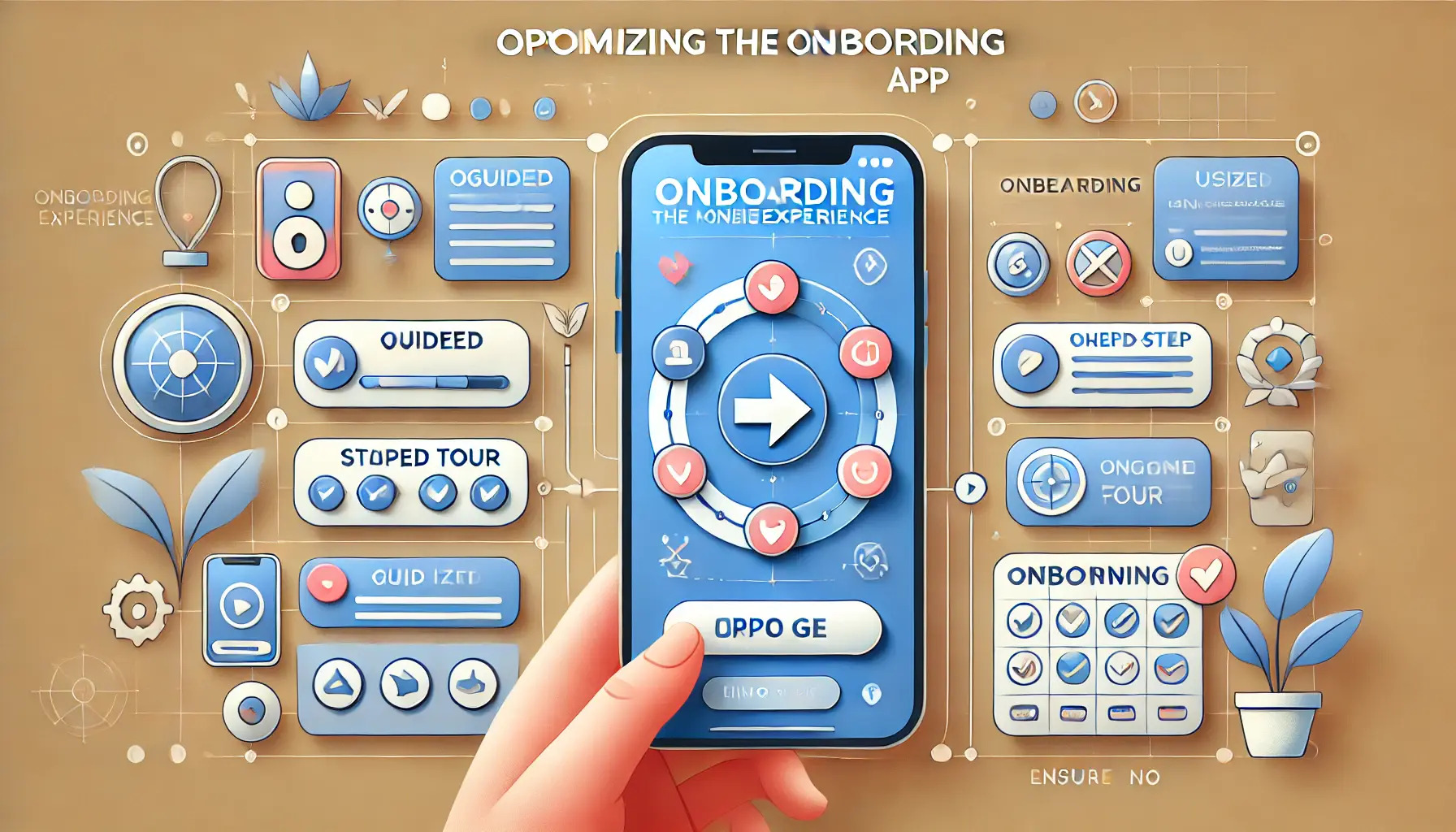
Illustration of a seamless and user-friendly onboarding experience in a mobile app.
Optimize the Onboarding Experience
Your onboardingThe process of guiding users through the initial setup and features of an app. experience is vital in turning free users into paying customers.
During this walkthrough, show customers the free services and mention your premium possibilities.
- Show Users Around: Use the onboarding process to show users how to access all the services available for free. Gently introduce them to the high-level ones as well.
- Offer the Benefits: Highlight the unique features of your premium version and get users excited about trying them out.

Illustration highlighting the concept of limited-time opportunities in a mobile app.
Use Limited-Time Opportunities
You can push users toward obtaining a premium plan by creating a deadline for making a purchase.
Limited-time opportunities and price reductions are two effective approaches to achieving this goal.
- Sale Products: Begin by partially reducing the price of your premium options. This creates a sense of urgency and can encourage users to make a purchase.
With the right balance between free and premium features, and by effectively using the freemium ASO revenue model, you can create a powerful revenue stream for your app.
The success of freemium models depends heavily on clear distinctions between free and paid features, along with effective onboarding strategies.
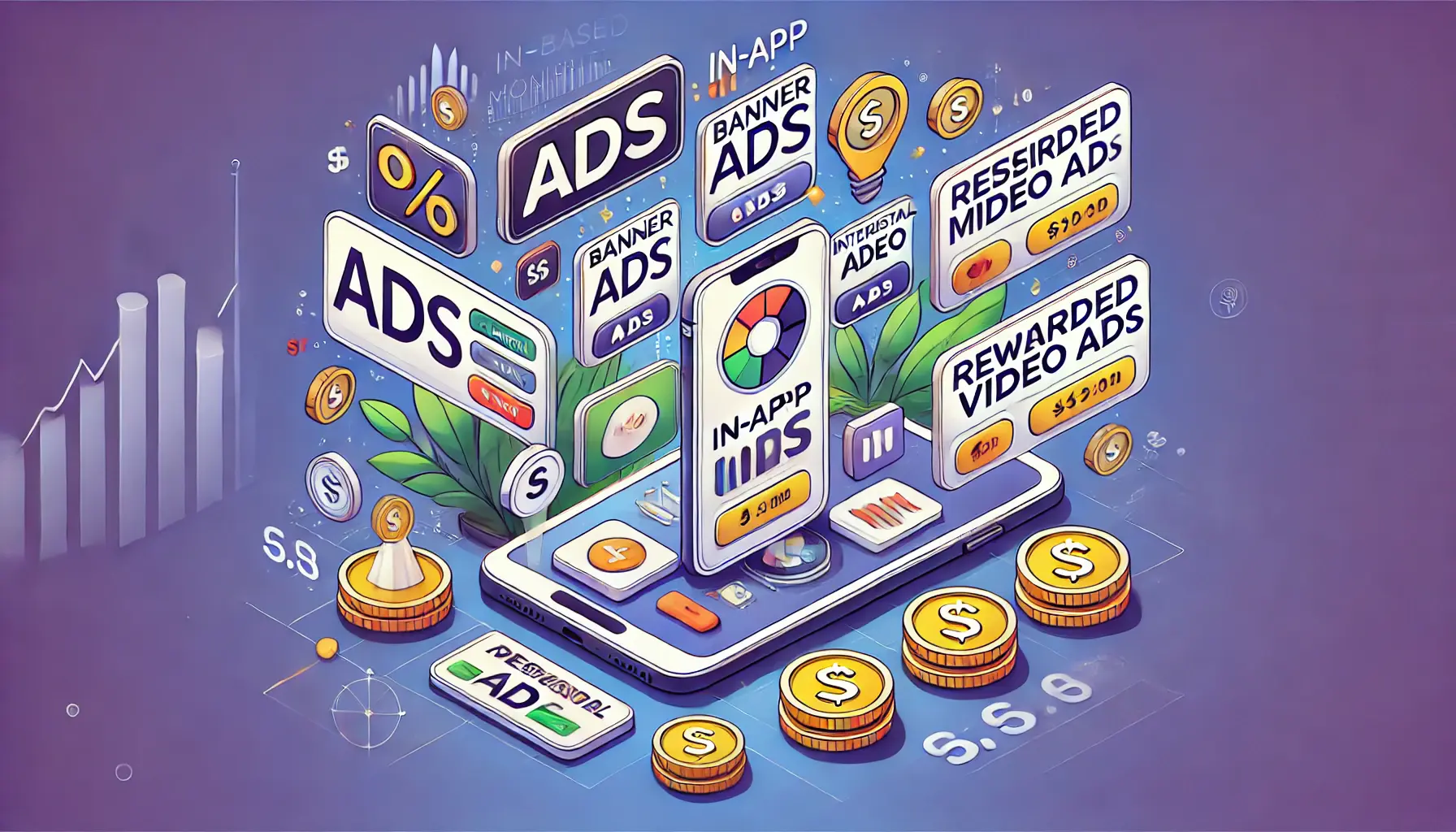
Illustration of ad-based monetization models in mobile apps, featuring different types of in-app ads.
Ad-Based Models: Monetizing Through In-App Ads
Apps with a large following or those providing services for free often rely on ad-based models to recoup their investment.
By integrating advertisements within your app, you can earn revenue while allowing users free access to your app.
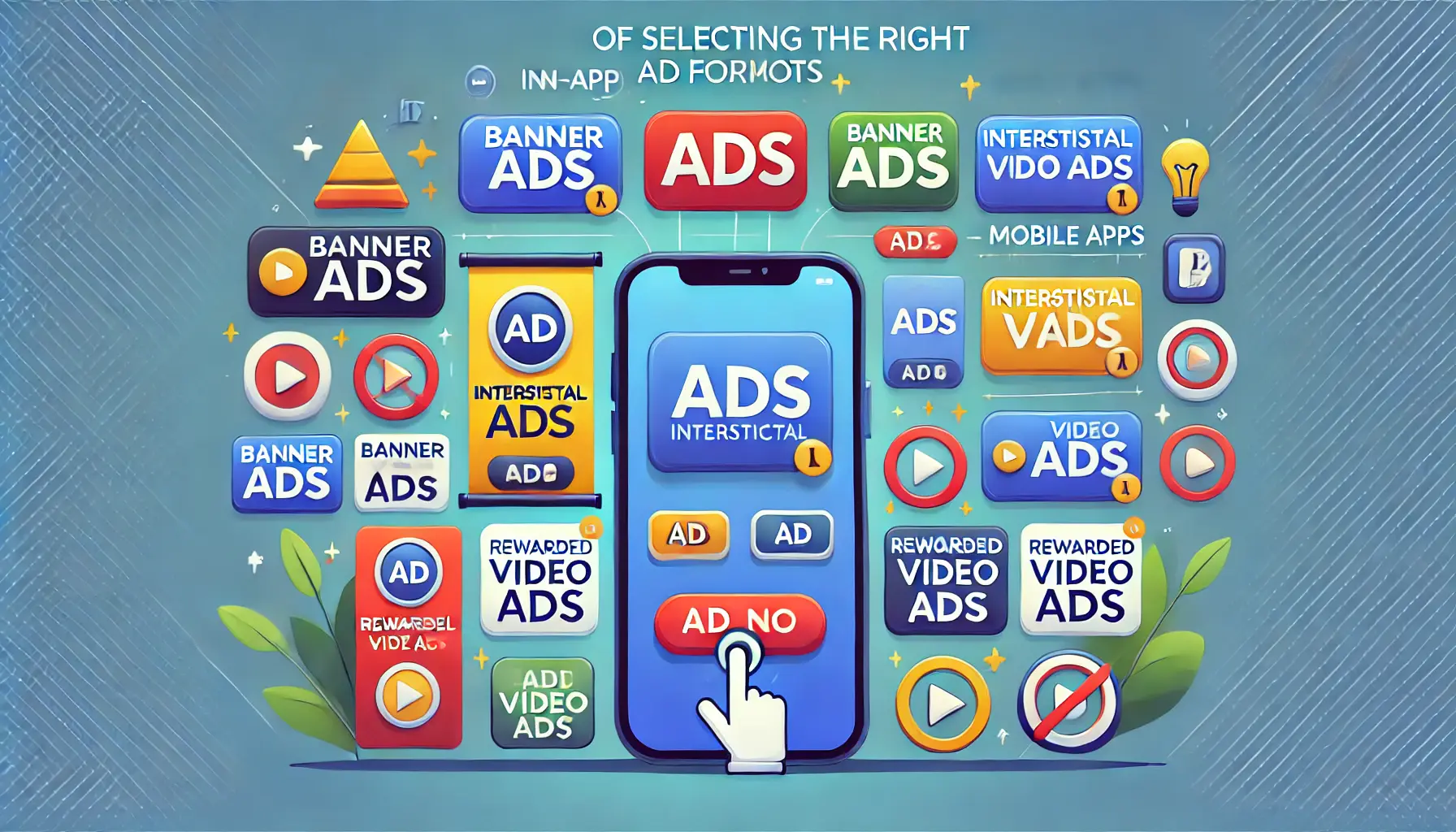
Illustration highlighting the selection of the right ad formats for optimal user experience and revenue generation in mobile apps.
The Right Ad Formats
Selecting the appropriate ad formats is key to maximizing returns from ad-based ASO revenue models without interfering with your app’s user experience and functionality.
- Banner Ads: These are small ads placed at the top or bottom of the screen. While less intrusive, they may generate less revenue compared to other formats.
- Interstitial Ads: These full-screen ads appear during natural pauses in the app, such as between game levels. They are generally more engaging than banner ads.
- Rewarded Ads: Users receive tangible rewards, such as in-game currency or additional features, in exchange for watching ads. This format tends to be highly effective as users willingly engage with ads for rewards.
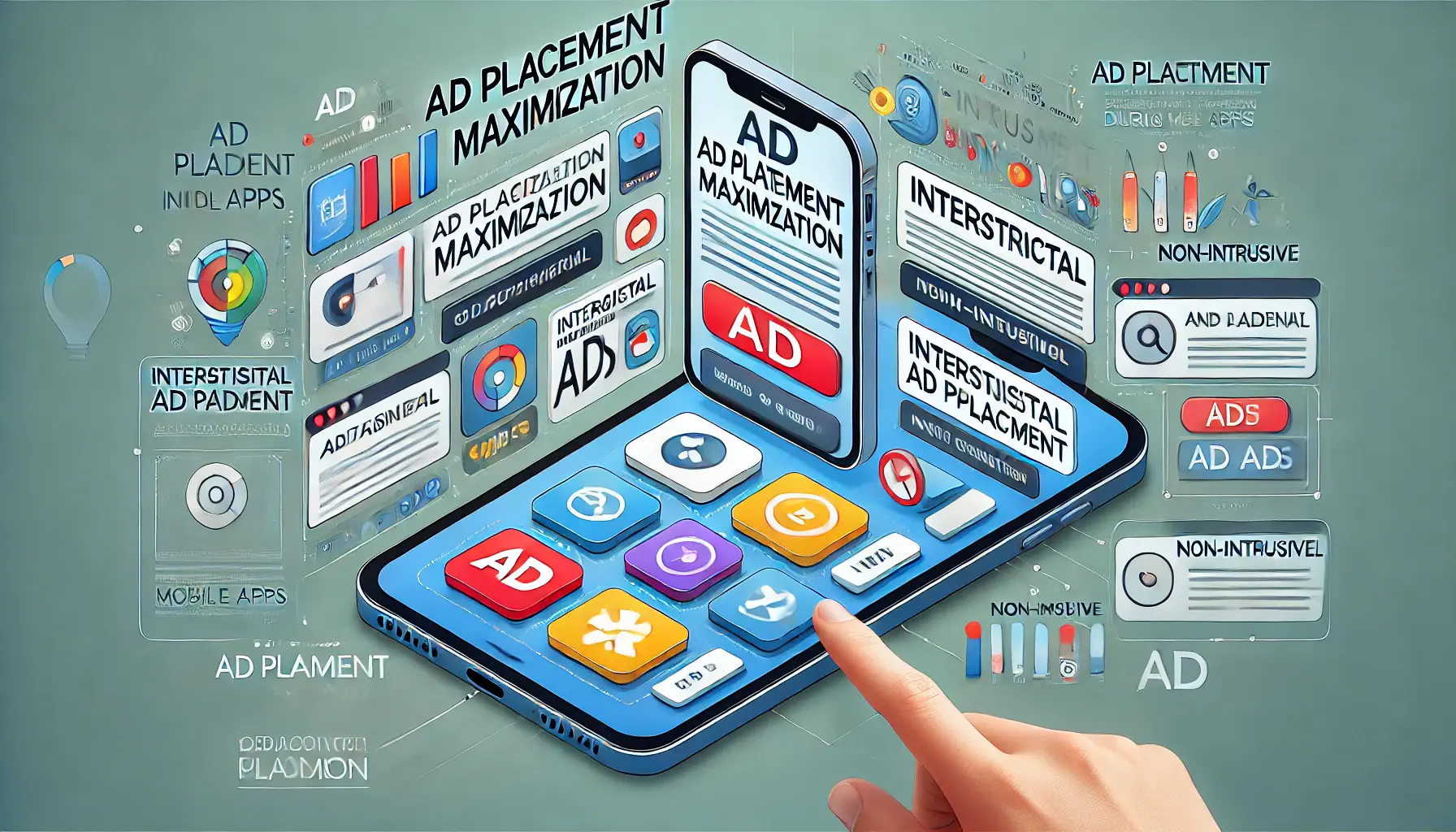
Illustration representing the optimization of ad placement in mobile apps for maximum visibility and minimal disruption.
Ad Placement Maximization
Effective ad placement within the app can significantly boost your ad-based revenue.
Here are some tips for maximizing profits from in-app advertising:
- Ad Frequency: Too many ads can disrupt the user experience and become annoying. Ensure that ads are placed in a way that allows for profitability without causing irritation.
- Non-Intrusive Placement: Ads should be placed in areas that do not interfere with key app functions or user interactions.
- Monitor and Iterate: Regularly analyze ad performance and its impact on user retention and engagement. Adjust placements based on user feedback and performance data.

Illustration emphasizing the importance of user engagement in mobile apps through interactive and dynamic visuals.
User Engagement
It’s crucial that monetizing your app through ads does not compromise the user experience.
Here’s how to improve user engagement while implementing ad-based revenue models:
- Value-Based Ads: Incorporate incentive-based ads that offer users rewards for engaging with them. This increases user engagement and reduces disruption.
- Transparency: Clearly inform users that ads help support the app and provide access to features that would otherwise be premium.
- User Feedback: Monitor user complaints regarding ad quantity and placement. Make necessary adjustments to maintain a positive user experience and retain users.
By carefully selecting ad formats, optimizing placement, and enhancing user engagement, ad-based models can effectively generate revenue while maintaining a positive user experience.
Ad-based models can be profitable but must be carefully managed to avoid disrupting the user experience.
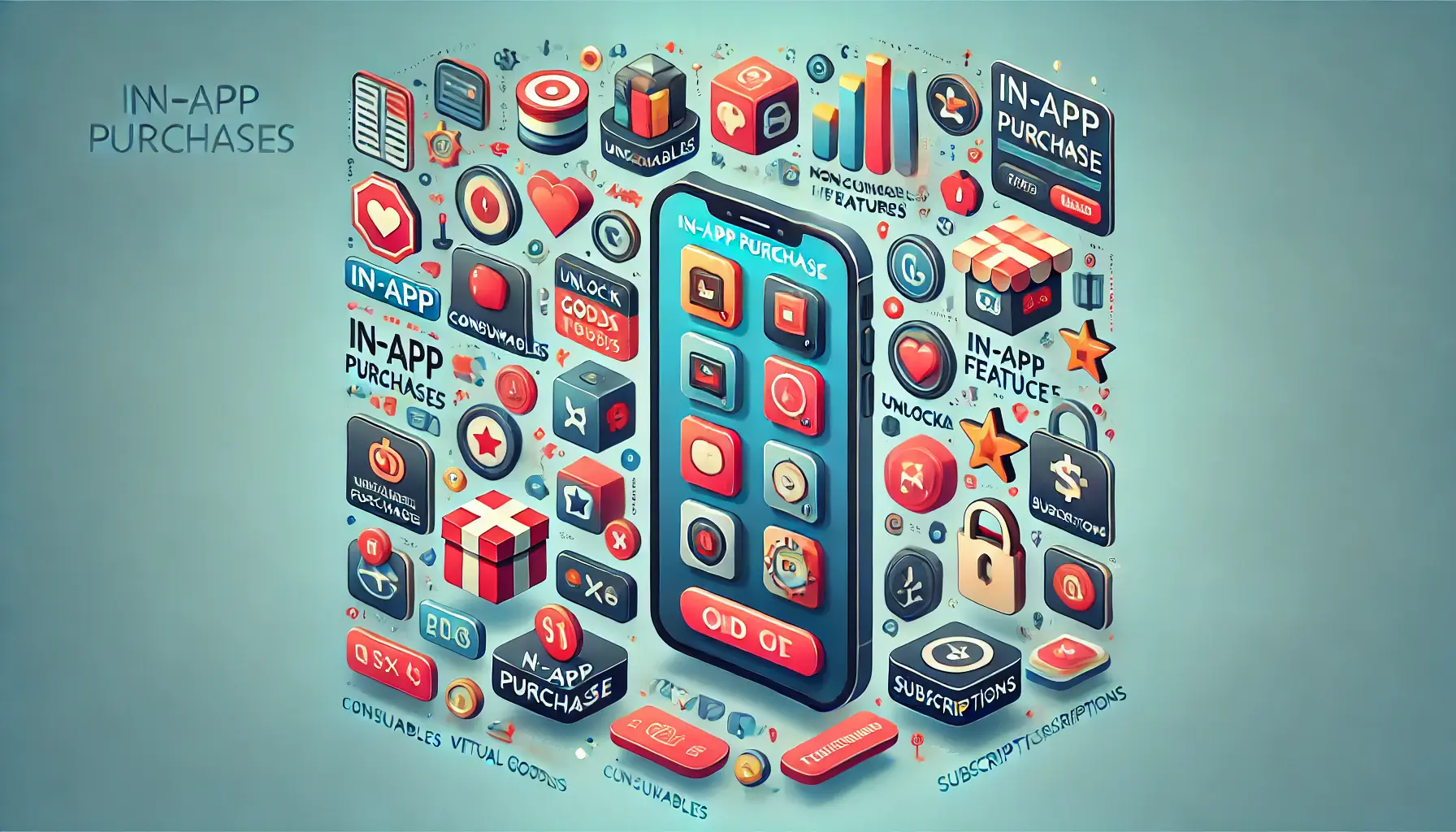
Illustration representing different in-app purchase types in mobile apps, designed to enhance user experience and revenue.
In-App Purchase Types: To Optimize User Experience & Revenue
In-app purchase (IAP) models let you earn income by offering additional content or features within your app.
This strategy can significantly boost your revenue while enhancing the overall user experience.
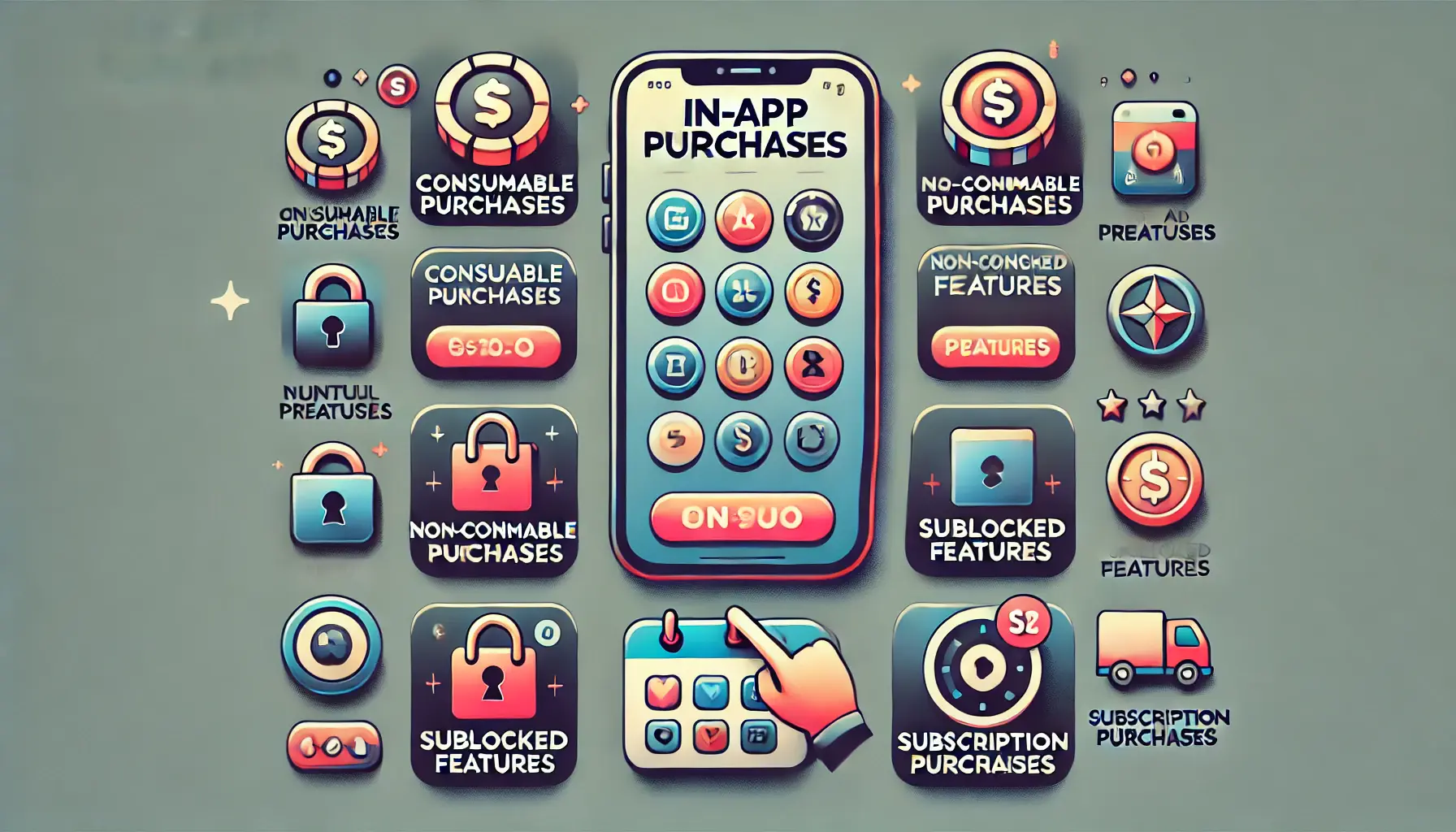
Illustration highlighting the different types of in-app purchases available in mobile apps.
Types of In-App Purchases
Understanding the different types of in-app purchases is crucial for creating an effective IAP revenue model.
Each type caters to various user needs and preferences.
- Consumables: These are in-app items that users buy and use, such as virtual currency for games or additional lives. Consumables are typically purchased repeatedly, leading to ongoing revenue.
- Non-Consumables: These purchases unlock features or content that users can access permanently, such as additional app functionality or the removal of advertising. Non-consumables do not need to be repurchased once bought.
- Subscriptions: Subscriptions provide users with continuous access to content or features for a recurring fee. This model ensures consistent, passive income.
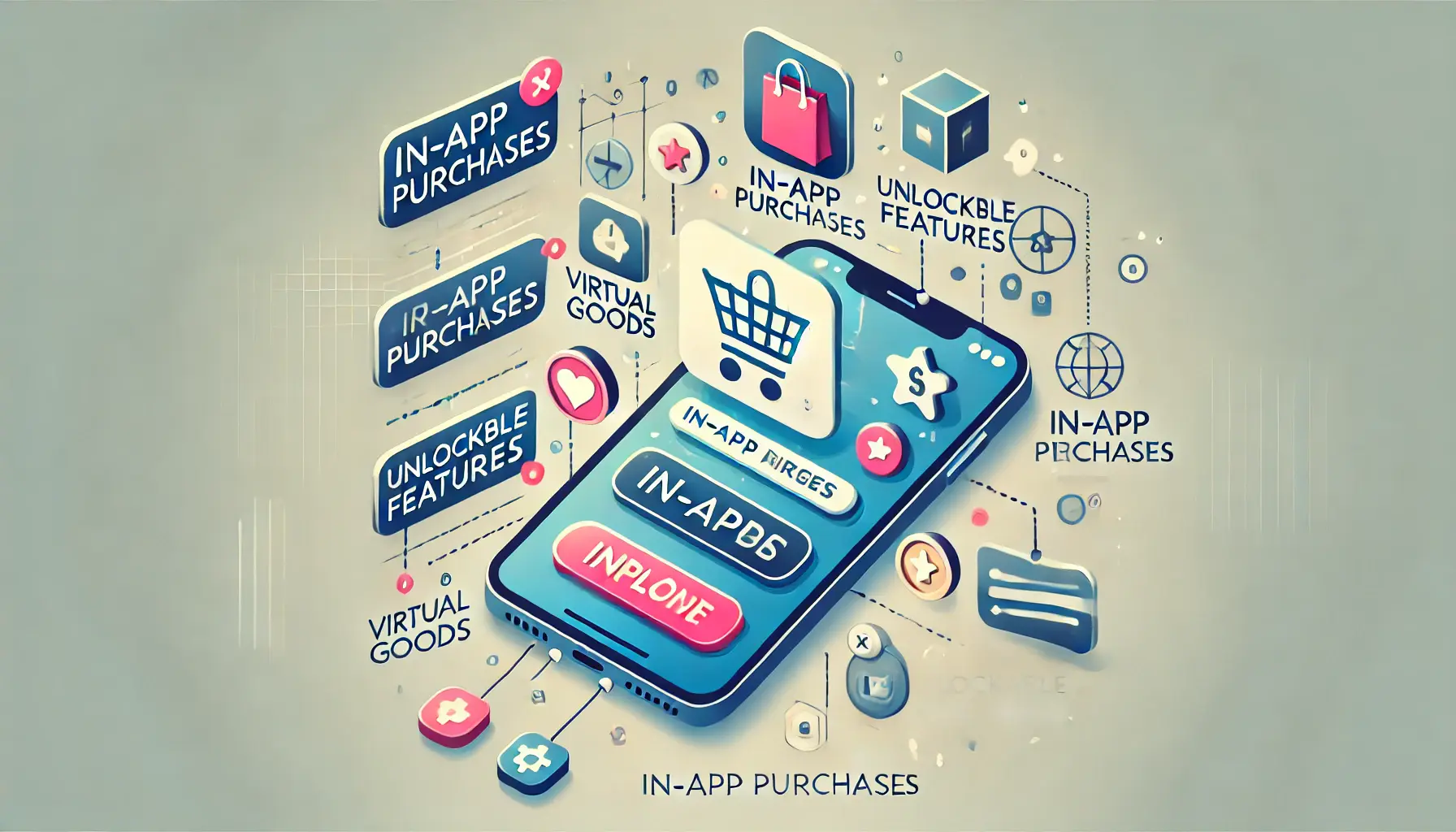
Illustration depicting the seamless integration of in-app purchases in a mobile app.
Implementing In-App Purchases
To ensure the effectiveness of your in-app purchase model, consider these best practices:
- Communicate Value: Clearly explain the value of in-app purchases to users. Make sure they understand what additional benefits they will gain from their purchase.
- Seamless Integration: The in-app purchase process should integrate smoothly with your application. Complicated or disruptive purchase processes can discourage users from completing transactions.
- Regular Updates: Keep your in-app purchase offerings fresh by regularly updating content and features. This encourages users to return and make additional purchases.

Illustration emphasizing the distinction between free and paid content in a mobile app.
Offering Free Versus Paid Content
Striking the right balance between free and paid content is essential for maximizing revenue while providing a good user experience.
Here’s how to achieve this balance:
- Offer Free Value: Provide high-quality content for free to attract users and encourage them to return.
- Highlight Paid Features: Ensure that the paid version offers substantial improvements over the free version. Users should clearly see the benefits of upgrading.
- A/B Testing: Conduct A/B testing to determine which in-app purchases are most appealing to users and adjust your offerings based on the results.
By leveraging in-app purchases effectively and maintaining a balance between free and paid content, you can enhance user experience and drive substantial revenue growth for your app.
Offering a variety of in-app purchase types allows for greater customization of user experiences and maximizes revenue opportunities.

Illustration of hybrid revenue models in mobile apps, emphasizing the synergy of combining different monetization strategies.
Hybrid Revenue Models: Strategy Collision For The Win
Through hybrid revenue models, you can combine different monetization strategies to maximize your app’s revenue by catering to all user groups.
This approach enables you to leverage the complementary aspects of different revenue models and build a more adaptable and redundant monetization strategy.
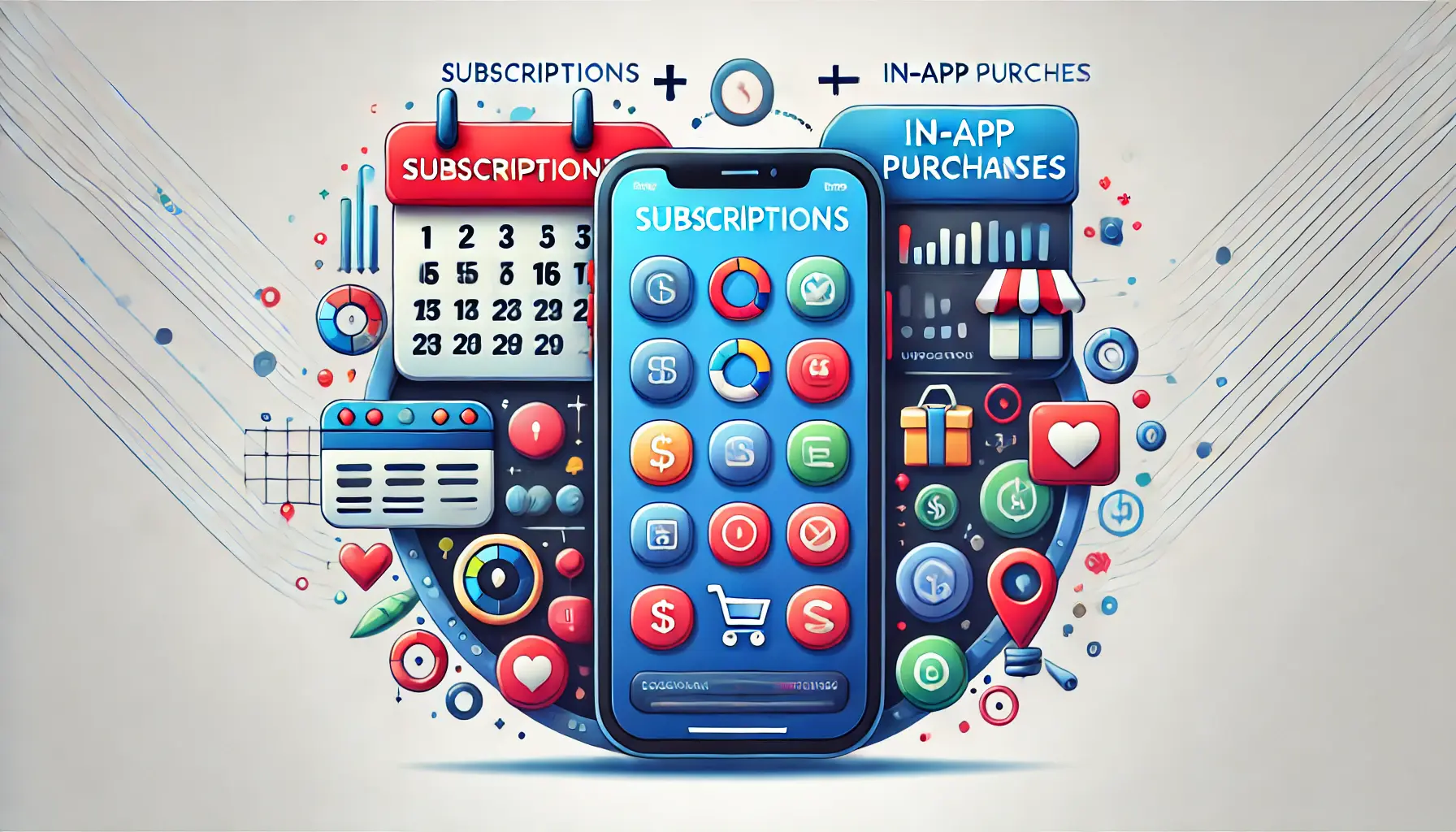
Illustration showcasing the combination of subscriptions and in-app purchases in mobile apps.
Combining Subscriptions and In-App Purchases
A hybrid revenue model that tends to be highly effective involves mixing subscription-based revenue with in-app purchases.
This model allows you to offer a free subscription-based service while selling advanced features or content via in-app purchases.
- Advantages of Subscription: Subscriptions provide consistent monthly recurring revenue, which imparts stability to your cash flow. They also keep users engaged with your app on an ongoing basis.
- Benefits of In-App Purchases: In-app purchases enhance the user experience by offering additional features or content on top of the subscription. This model effectively caters to both free and paid users.

Illustration representing the hybrid model combining ad-based monetization and in-app purchases in mobile apps.
Ad-Based and In-App Purchase Hybrid
Another effective hybrid approach combines ad-based revenue with in-app purchases.
This model allows you to earn revenue through advertisements while providing users with the option to pay for removing ads or accessing premium features through in-app purchases.
- Ad-Based Revenue: Ads generate a steady stream of revenue from users who do not make purchases. This model is especially effective for apps with a significant user base.
- In-App Purchase Options: Offering in-app purchases gives users the choice to remove ads or access extra features, creating a better user experience and stronger revenue.

Illustration representing the balanced hybrid model in mobile apps, where different monetization strategies are integrated seamlessly.
The Balanced Hybrid Model
Balancing different monetization strategies is crucial for creating a successful hybrid revenue model.
Consider the following tips:
- User Preferences: Understand your users’ preferences and identify which combination of revenue models will be the best fit for them.
- Performance Monitoring: Continuously monitor the performance of each revenue model in real-time. Make frequent adjustments based on the data to maximize revenue.
- Iterate: Be prepared to adapt your monetization strategy as your app evolves and user preferences shift. Regularly update and refine your strategy to stay aligned with market trends.
By integrating multiple revenue models, you can create a monetization strategy that maximizes your app’s revenue potential while catering to diverse user needs.
Hybrid revenue models offer flexibility and resilience by combining multiple monetization strategies to cater to diverse user preferences.
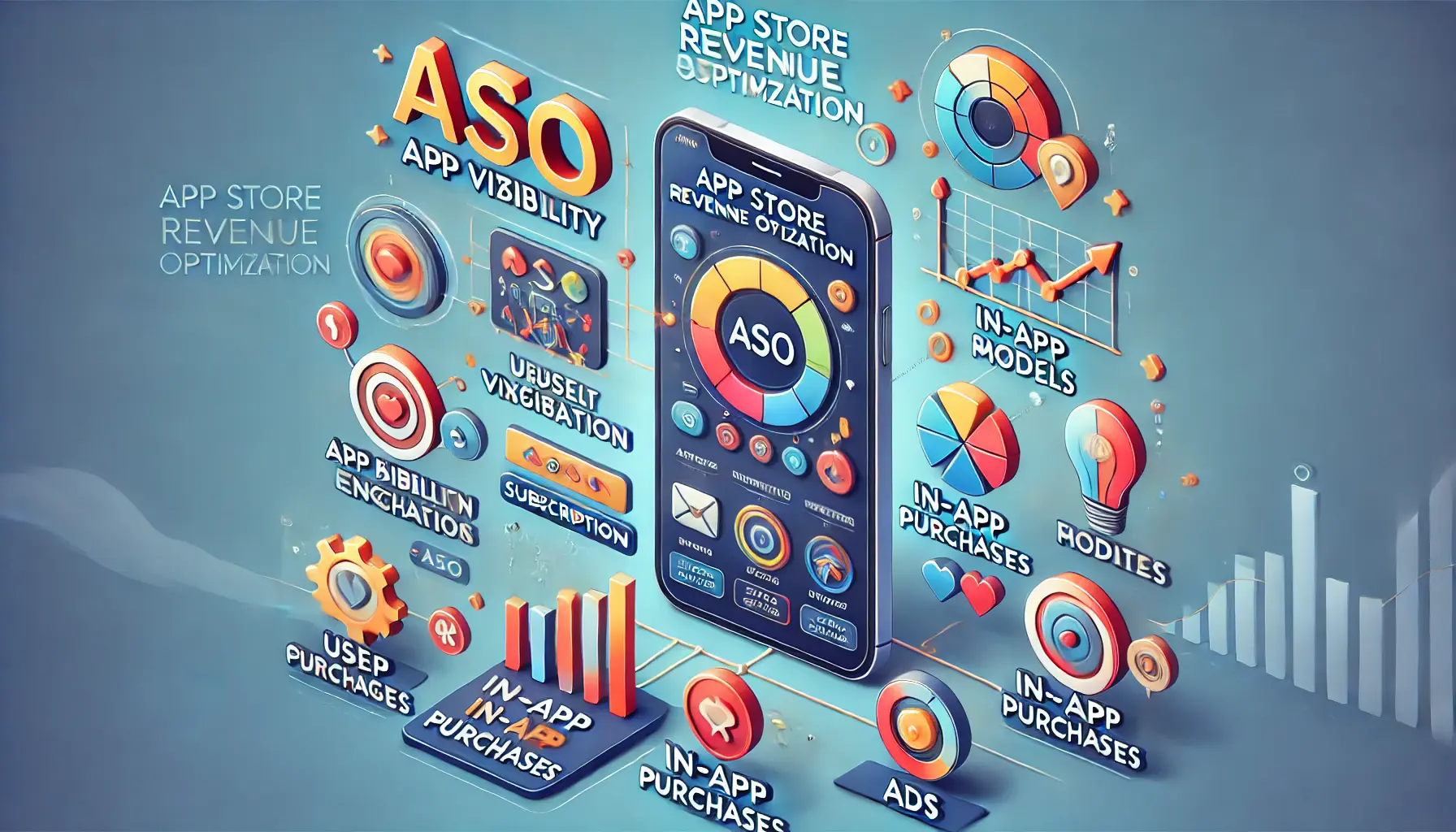
Illustration representing the conclusion of app store revenue optimization using ASO models.
App Store Revenue Optimization ASO Models — A Conclusion
To maximize your revenue potential from your iOS and Android app in the App Store, leveraging the best App Store Optimization (ASO) revenue models is crucial.
These models offer alternative solutions to traditional app store SEO approaches and can often provide better targeting capabilities compared to simply increasing user numbers.
Given the highly competitive nature of the app marketplace, selecting the ideal monetization model is essential to tap into its maximum potential effectively.
With the help of various ASO revenue models, you can monetize your application more strategically while keeping user experience in mind.

Illustration depicting the exploration of key revenue models in mobile apps.
Exploring Key Revenue Models
Each revenue model has distinct advantages and appeals to different audience segments.
Here’s a guide to the most effective revenue strategies for your app:
- Subscription-Based Models: Users pay a recurring fee to access premium features or a set number of stories each month. This model not only generates a steady flow of income but also encourages users to return for regular updates and enhancements.
- Freemium Models: Freemium models attract users with free access and generate revenue through premium features. Success in this model depends on clearly differentiating between free and paid functionalities, optimizing the onboarding process, and creating time-limited opportunities.
- Ad-Based Models: In this model, your app is free to download, and revenue is generated from ads included within the app. It’s crucial to select the right ad formats and ensure that ads do not disrupt the user experience.
- In-App Purchases (IAP): Offering consumables, non-consumables, and subscriptions can drive up revenue. Successful implementation requires a clutter-free design, clear value propositions, and a balance between free and paid content.
- Hybrid Revenue Models: Combining multiple monetization strategies, such as subscriptions with in-app purchases and ads, can create a flexible and robust revenue approach. This model caters to different user demands and maximizes revenue streams.
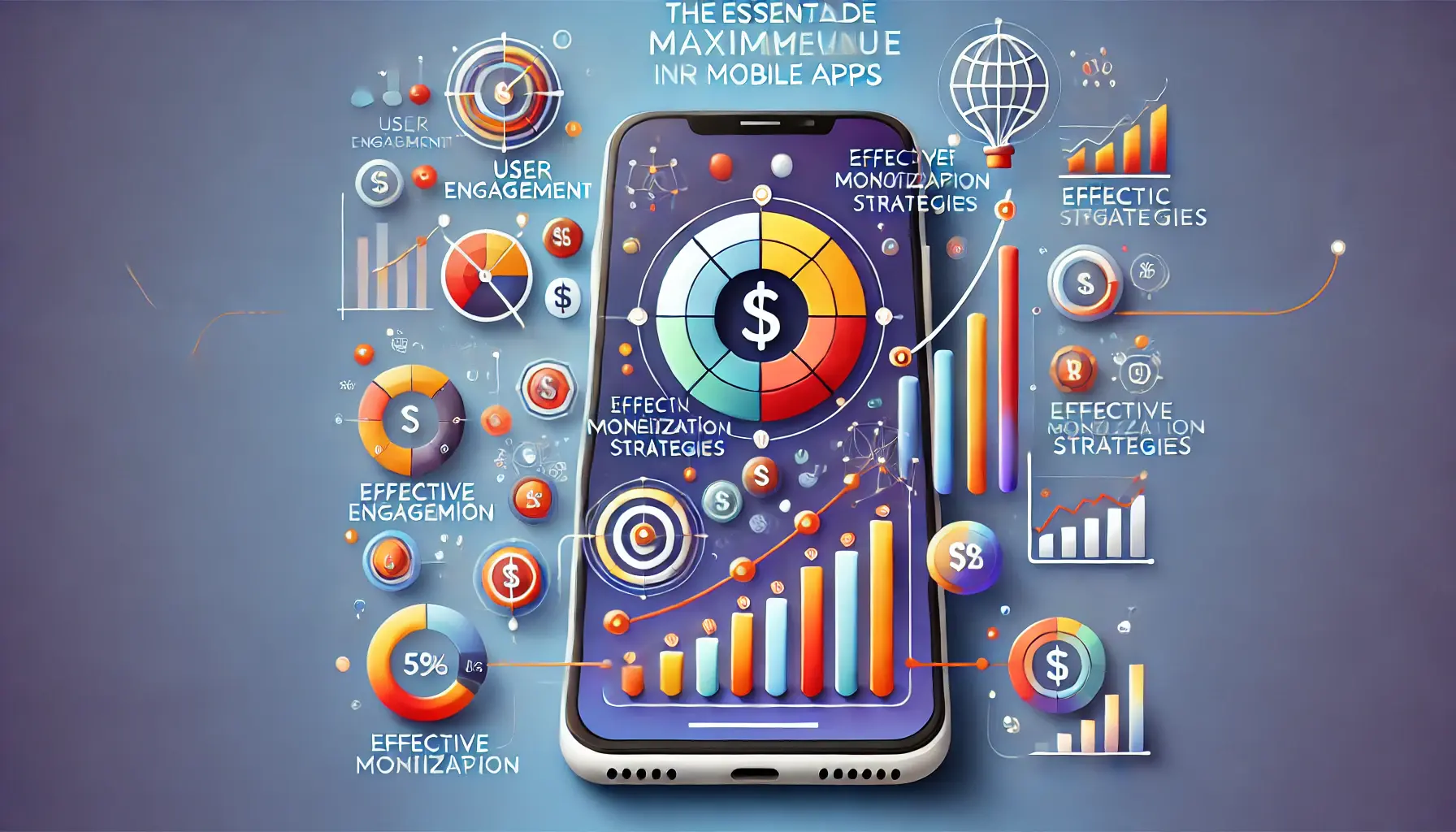
Illustration representing the essential knowledge for maximizing revenue in mobile apps.
What You Need to Know for Maximum Revenue
To optimize your monetization strategy effectively, consider the following:
- Understand User Needs and Habits: Ensure your revenue model aligns with user preferences and provides value.
- Iterate: Regularly revisit and refine your monetization techniques based on performance data and user feedback.
- Balance Monetization Efforts: Keep a good balance between free and premium features to maintain user engagement without overwhelming them.
- Adapt to Changes: Be agile and adjust your strategies as market trends and user preferences evolve.
By implementing these ASO revenue models appropriately, you can maximize your app’s income potential while delivering value to your users.
Remember, successful app monetization requires understanding your audience, adapting to their needs, and optimizing for long-term profitability with a strong focus on user experience.
Effective app store revenue optimization involves selecting the right monetization model tailored to your app’s unique user base and market conditions.
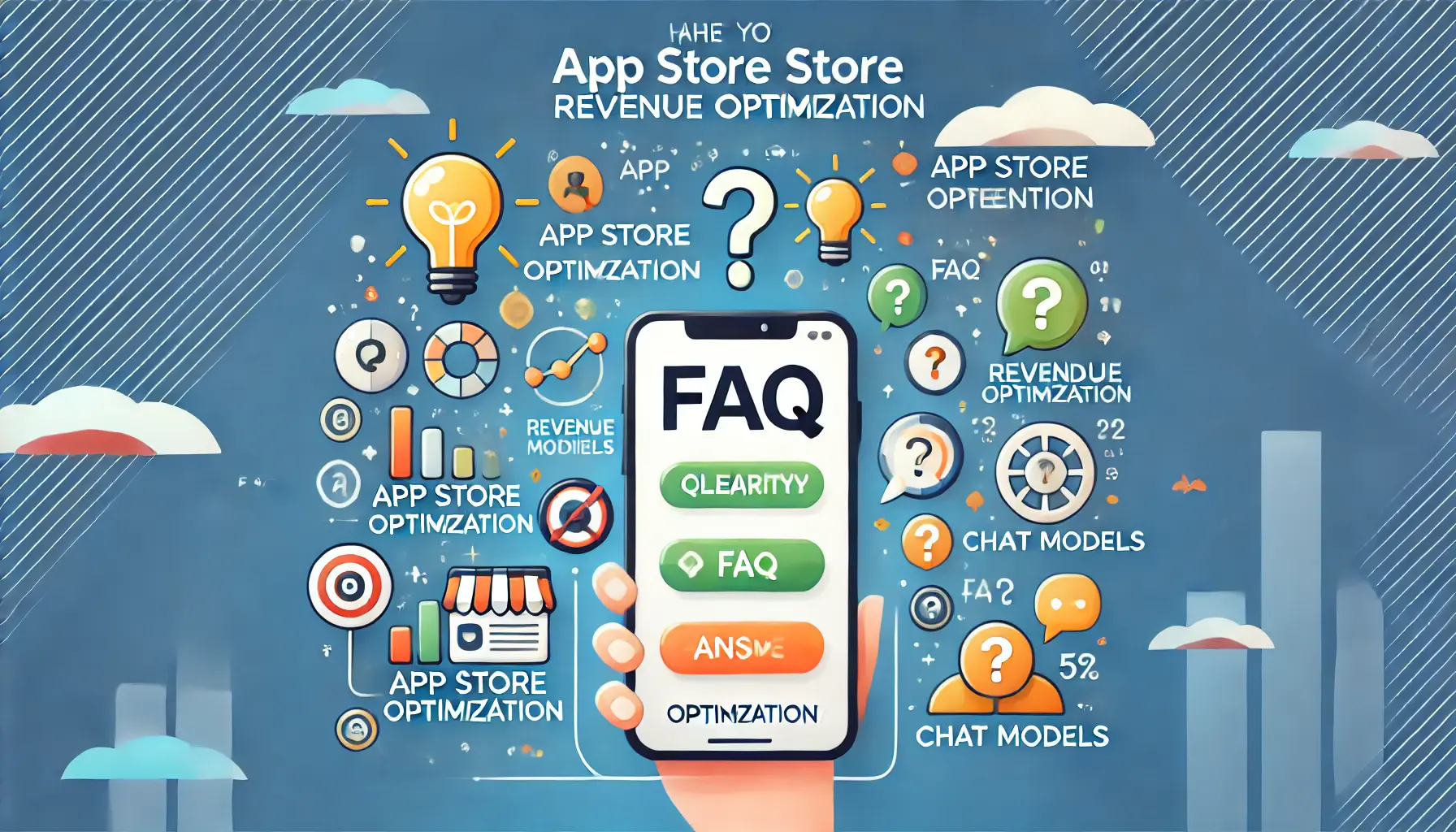
Illustration representing a FAQ section focused on app store revenue optimization.
Boost your mobile app's success with our guaranteed App Store Optimization (ASO) service. Leave it to the experts!
App Store Revenue Optimization FAQ
If you are looking to increase your earnings through different ASO approaches, we will address some common questions and answers on the subject.
An ASO revenue model is a strategy for generating income through app store optimization techniques.
It involves increasing app visibility and leveraging various monetization methods to maximize revenue.
In a subscription model, users pay a recurring fee for continued access to premium features or content, providing a predictable revenue stream and ensuring ongoing user engagement through updates.
Freemium models offer basic features for free and charge for premium features, whereas premium models require upfront payment for full access to the app’s content or features.
The best strategy depends on your app’s audience, usage patterns, and market trends.
Choose a model that maximizes revenue potential while maintaining a positive user experience.
In-app purchases (IAP) are transactions within the app for additional content or features.
They can be consumable, non-consumable, or subscription-based, each offering different revenue opportunities.
Ad-based models generate revenue by displaying ads within the app.
Revenue comes from ad impressions, clicks, or interactions, allowing you to earn while keeping the app free for users.
A hybrid revenue model combines multiple monetization strategies, such as subscriptions, in-app purchases, and ads, to create diverse income streams and meet various user preferences.
Offer valuable free content to attract users and incentivize upgrades to paid features.
Clearly distinguish between free and premium offerings to encourage users to see the benefits of upgrading.
Maintaining a great user experience is essential for user retention.
Monetization should enhance the user experience, not disrupt it, to drive long-term engagement and profitability.
Track key metrics such as user engagement, revenue per user, and conversion rates.
Regularly review performance data to make informed adjustments and optimize your monetization efforts.
Consumable in-app purchases are items like virtual currency or extra lives that users buy and use up.
These often lead to repeat purchases as users need to buy them again.
Non-consumable in-app purchases unlock permanent features or content, such as removing ads or adding functionalities, and only need to be purchased once.
Conduct A/B testing to compare different monetization strategies and determine which yields the best results.
Use the data to refine your approach and optimize revenue generation.
Effective onboarding helps users discover the app’s value and premium features, leading to higher conversion rates for paid plans and features by providing a better initial experience.
Choose ad formats that fit seamlessly into the app, such as banners or interstitialFull-screen ads that appear at natural transition points in an app, such as between levels in a game.s, that appear during natural breaks or transitions in the app to avoid disrupting the user experience.
The freemium model attracts users with free access and generates revenue from premium features.
It helps grow the user base and monetizes those willing to pay for additional benefits.
Combine revenue models like subscriptions, ads, and in-app purchases to target diverse user preferences.
Continuously analyze and refine your approach to maximize revenue through multiple streams.
Ensure the subscription offers real value, is updated regularly, and enhances the app experience.
This will help retain existing subscribers and attract new ones.











